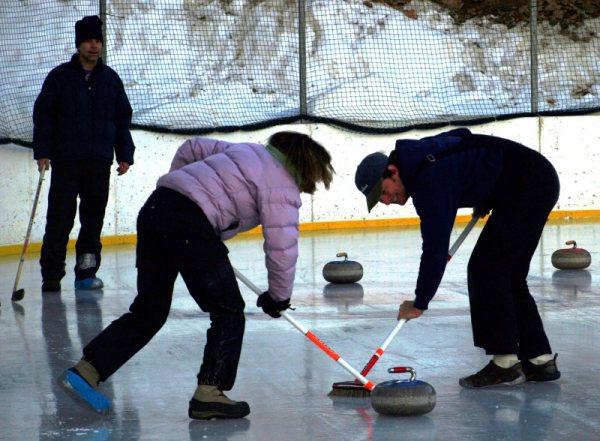 On a cold and frosty Monday night in January, you can find a hearty clan of eight or so people out on the Nederland ice rink sliding a round stone towards a target etched into the ice. Yes, the Nederland curling club is engaged in the yet another robust bout of winter curling. I don’t know about you, but up until the 2002 Salt Lake City Olympics, I thought curling was something one did to one’s hair with a curling iron. But I was lucky enough to attend the Olympics in 2002 and though I didn’t actually attend a curling match in person, I did get to know just a bit more about this rather esoteric sport. In the Olympic Square, there was even a miniature curling rink set up for us mere mortals to try our hand at. And what an odd sport it is!
On a cold and frosty Monday night in January, you can find a hearty clan of eight or so people out on the Nederland ice rink sliding a round stone towards a target etched into the ice. Yes, the Nederland curling club is engaged in the yet another robust bout of winter curling. I don’t know about you, but up until the 2002 Salt Lake City Olympics, I thought curling was something one did to one’s hair with a curling iron. But I was lucky enough to attend the Olympics in 2002 and though I didn’t actually attend a curling match in person, I did get to know just a bit more about this rather esoteric sport. In the Olympic Square, there was even a miniature curling rink set up for us mere mortals to try our hand at. And what an odd sport it is!
For those of you in most parts of the country that probably don’t have a curling league, curling is a winter sport that originated in Scotland in the 1600s. It is played on an ice surface, usually a rink, between two teams of four players each. There are targets (think three circles similar to the target you use to shoot arrows at) etched in the ice about 150 feet apart. There is a very large stone, that sort of looks like a large tea kettle with a handle on top. The skip (thrower of the stone), slides the stone down the ice, releasing it and trying to get it as close to the bulls eye as possible. Along the way, two sweepers with brushes can sweep or brush the ice to influence the path of the stone, speeding it up, slowing it down, or even getting it to “curl”. The team with the stone closest to the bulls eye wins points after all stones have been thrown at each end (sort of like an inning in baseball). Nederland games of curling consist of eight ends, and whoever has the most points, wins. The curling stones are around 40 pounds each, and made of a particularly kind of granite sanctioned by the World Curling Federation and are only found in the United Kingdom (Scotland and Wales). Because they can be so costly, Nederland’s curling league purchased second-hand stones from another more established curling club. More about curling here….
Curling is most popular in Europe and in Canada, and suffice it to say, most of us in the U.S. are not found curling on Monday nights or Saturday afternoons. But in 1998, some Ned residents got together and formed a curling club, and it has gotten quite popular with the local residents. Our neighbor, Ed, is quite dedicated to his team, and can’t wait for curling to begin each winter. There are curling leagues in other parts of Colorado on fancy ice rinks, but here in Nederland, the curling surface is created rather ingeniously by using the town tennis courts. They remove the nets during winter, and when deemed cold enough, flood the tennis courts to create the ice surface. As you can imagine, it is not particularly level or even, which can make for some interesting final destinations of where the curling stones end up. Also, our curling is played outside in conditions that can range from a rather balmy 40 degrees or more to downright bone-chilling nights of temperatures below zero. Curling in Nederland is equal opportunity, and because it’s not really a physical sport, teams are often comprised of both men and women, although a few years ago, a woman’s only team formed calling themselves the “Girlers.”
Though I haven’t yet become serious about curling enough to join a team, it’s fun to go out and cheer on our friends and neighbors, and maybe imbibe in an Irish Coffee or two from the thermos as well. And who knows, maybe one of those kids I’m watching on a cold night in Nederland, will become a future curling Olympian…

